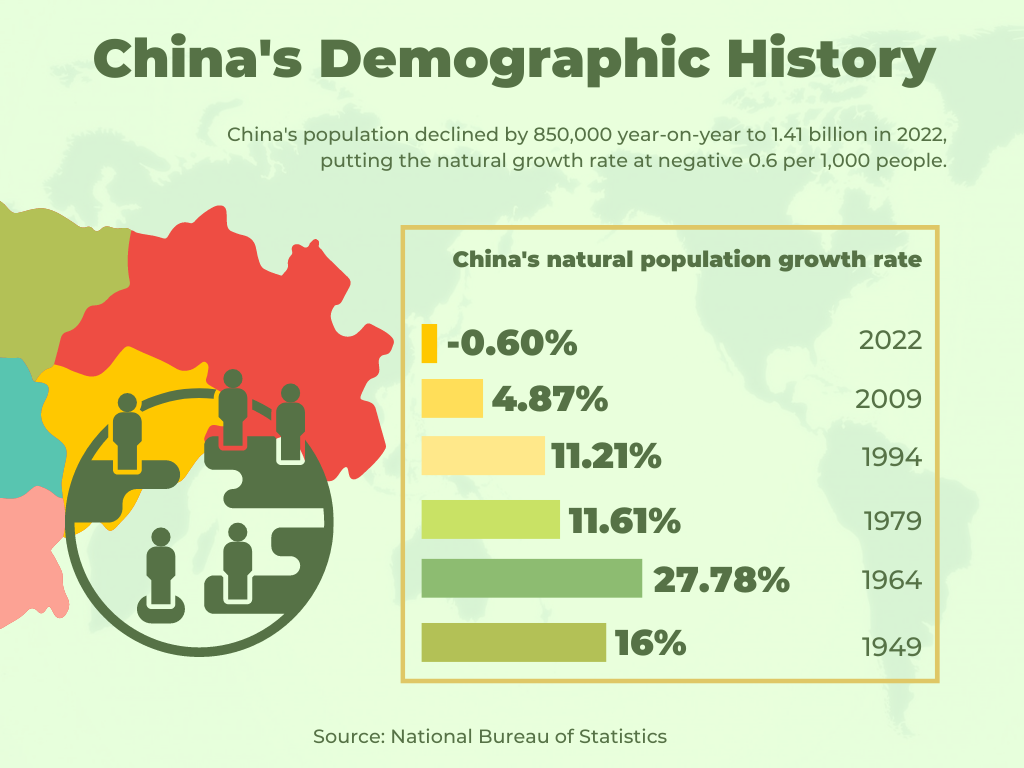Chongqing- Despite the negative growth in the national population in 2022, five provincial regions located in central and western China saw an increase in the permanent resident population, including Southwest China's Chongqing Municipality.
Bridging News had an exclusive interview with Luo Wei, deputy director and associate researcher of the Institute of Law and Sociology, Chongqing Academy of Social Sciences, to share his insights on the economic and social phenomenon behind it.
According to the National Bureau of Statistics, China's population declined by 850,000 year-on-year to 1.41 billion in 2022, putting the natural growth rate at negative 0.6 per 1,000 people.
The negative growth in China's population serves for the first time over six decades.

China's natural population growth rate from 1949 to 2022. (Graphics/ Chen Zhan)
As China is the world's most populous country, the government bears heavier economic and social responsibilities than many others, with changing policies and following measures.
In 2015, China abandoned its decades-long one-child policy, allowing couples to have two children. In 2021, this was expanded to a third child for each family.
Indeed, the government proposed supportive measures in each place, including reducing childbirth costs, safeguarding the rights and interests of female employees, and addressing the concerns of women of childbearing age.
Luo estimated that China's negative population growth would likely be a long-term trend, mainly influenced by declining fertility intentions and the rising age of first marriage and childbearing.

People visit Chongqing Liangping District with their families and loved ones to buy New Year's goods. (Photo/ Liangping District)
Demographic changes and deepening aging require reorganizing the public policy system, posing a significant challenge to government management.
Based on the current situation, Luo suggests that more advanced assisted reproductive technologies are needed to help people have children and improve the quality of their offspring.
Also, it is necessary to balance the technological replacement of the workforce and employment priority strategy, as the structural shortage of employment will continue to exist for a long time.
The world population hit eight billion on November 15, 2022. However, the number is forecast to increase in the next few decades at a slower pace due to the decline in both fertility and mortality, according to the World Population Prospects 2022 report released by the United Nations.
The conclusion holds true for Luo as well. He believes the dropping desire for fertility has become a common issue faced by the world, especially in developed countries.

Statistics of the world population by country in 2022. (Graphics/ Chen Zhan)
The population situation varies from place to place. As China announced its first population decline in decades, five provincial regions saw positive growth last year, including Chongqing, Jiangxi, Guangxi, Qinghai, and Gansu.

The night view of Southwest China's Chongqing. (Photo/ Chongqing Daily)
Chongqing's resident population stood at 32.133 million by the end of 2022, maintaining a growth of 9,000 people year-on-year, according to the Chongqing Municipal Bureau of Statistics.
Luo said that Chongqing's positive growth sends a strong signal of its development momentum, which will significantly enhance the city's image in the country and the world.
He explained that regional population growth is divided into natural and mechanical development. If viewed from two separate indicators, the natural population growth in Chongqing has been negative for three consecutive years, while the population has grown mechanically.
Luo said this was driven by the dual factors of increased foreign population inflow and decreased local people's outflow.

Chongqing's population situation in 2022. (Graphics/ Chen Zhan)
Another explanation is that Chongqing has boosted economic development by increasing local employment opportunities in recent years, said Qu Yan, the person in charge of the Chongqing Comprehensive Economic Research Institute.
Enhanced by economic strength, public services, and the ecological environment, more talents have come to Chongqing to live and work, increasing 100,000 people annually since 2015.
Qu suggested that Chongqing should seize opportunities to gather human resources and create favorable conditions for workers returning to their hometowns, like implementing the employment and housing project.
Luo expected a bright future for Chongqing that would become China's important growth pole to gather more talent.
By then, the newly assembled population will trend younger with a higher level of education, while the city's population structure and quality will be further optimized.
By continuing to browse our site you agree to our use of cookies, revised Privacy Policy and Terms of Use. You can change your cookie settings through your browser.
For any inquiries, please email service@ichongqing.info